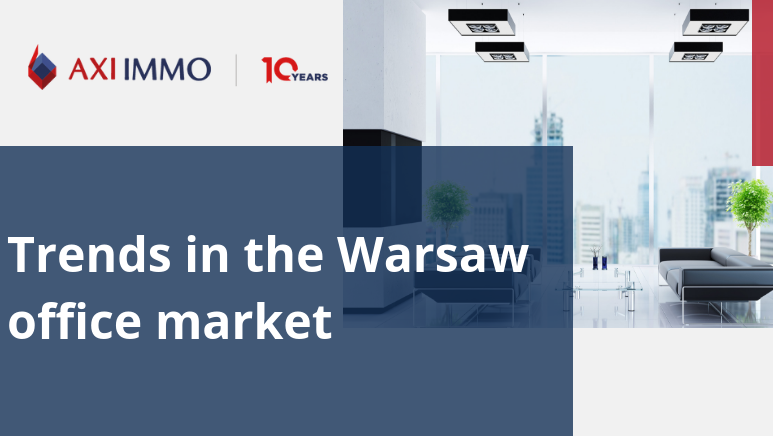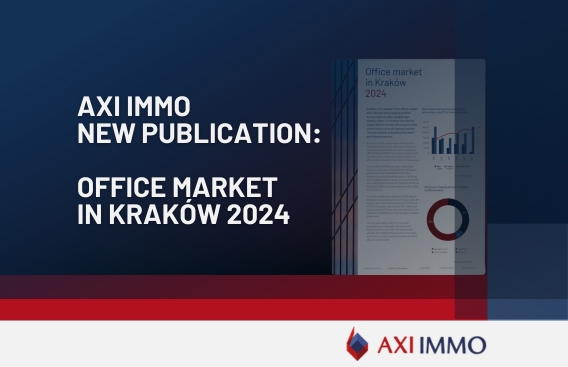Report: Trends in the Warsaw Office Market 2019
AXI IMMO Report Office market in 2019 - directions of changes and development of the office market in Warsaw.

The Warsaw office market stays on a stable path of development. Tenants’ interest in space does not diminish. In 2018, 1.5 million sq m was leased, which is a result comparable to that achieved in 2017. The sector is doing well and strengthening its position, mainly due to the growing role of the office in attracting young generations. Although we are currently observing the growing supply gap (only 2 projects have been completed in Q1 2019 – 20,000 sq m), forecasts for the sector are optimistic, as Warsaw is building over 770,000. sq m, of which ¼ is to be commissioned by the end of this year. AXI IMMO experts have prepared a report about directions for changes and the development of the office sector in Warsaw.
| Download report: | Report – Trends in the Warsaw office market 2019 | Download for free: PDF | 1 MB |
The office sector remains on the wave, which determines the changing labour market and younger generations of employees. The office, both its arrangement and location take on even more important than before, being one of the main factors considered by employees choosing future employers. Companies fight with each other for creating modern and unconventional office space, looking for them in locations that provide not only an attractive workplace but also a wide range of opportunities to spend free time outside it and organize the necessary daily affairs. The struggle for employees that currently take place positively affects the office sector and its development, influencing the creation of new trends in the arrangement office and mix-use location or implementation of new technologies in workplaces. However, it also has less beneficial sides such as an increase in costs for office. – comments Martin Lipiński, director at office department at AXI IMMO.
More and more coworking space
Demand for flexible space has been growing steadily for several years. In 2018, coworking operators in Warsaw rented over 100,000 sq m, which is around 12% of the total demand for office space in the city. It is estimated that in 2019 another 100,000 sq m of coworking space will be available in Poland, which means that at the end of next year, more than 200,000 sq m of flexible space will be available to tenants.
Increased interest in this format results from changing labour market, i.e. a growing percentage of flexible forms of employment, remote working, an increasing number of freelancers, and the rapid increase
Growing supply gap
2018 saw the lowest vacancy rate since 2012, which was 8.7%. The central part of the city had an even lower rate of 5.4%. Developers completed almost 16% less office space than in 2017. The first quarter of this year did not improve the situation, as only 20,000 sq m went to the market. The low level of supply vs. growing demand, especially for modern space, is creating a supply gap in the market. Only in 2020- 2021 will this change, as it is estimated that about 600,000 sq m of modern office space will be delivered to the market.
Strengthening the role of the office
New generations of employees will dominate the labour market. Employers are increasingly trying to create attractive working conditions for young employees, not only in terms of pay but more and more often in terms of creative benefits. In the battle to attract talented staff from younger generations, innovative and creative office space is becoming standard. That is why, in the near future there will be more and more new solutions in office design. In 2019, the arrangement of office space will be dominated by the eco trend and a home-like atmosphere in the workplace.
Increase in office arrangement and fit-out costs
The fit-out, or the comprehensive adaptation of office space taking into account design and building work, is playing a much more important role than a few years ago. The growing demand for this type of space brings with it a large increase in costs. The cost of arranging office space has doubled in the last three years, from an average of EUR 300 to 600 per sq m. Furthermore, in the best designs, the fit-out cost can reach as high as EUR 900 per sq m.
Technologies in offices of the future
Changes in the style of work are requiring companies to invest in new technologies that help not only attract employees but also optimise work in the organisation. Therefore, offices of the future will feature technologies that allow users to check the availability of individual zones and book meeting rooms, the placement of staff within an office that will significantly facilitate communication and cooperation with particular departments, as well as direct printing from smartphones and changing the intensity of light. Everything to improve work.
Staff do not live by the office alone… the role of the city
A good location, which today does not only mean good transport links, is of key importance in attracting and maintaining talented staff. The surroundings of an office are playing an increasingly important role. Tenants are willing to pay more to lease space in a location that offers more than just a convenient commute and an attractive interior. That is why they are increasingly passing on typical office locations for space in places with access to urban services that significantly improve the comfort of work and private life. That is why developers planning to build office buildings are increasingly focused on locations that already have ‘urban fabric’.
Maybe he will also interest you in a report about trends in the warehouse and logistics market in Poland.
Recent articles
14 April 2025
New Work expands in Warsaw with new serviced offices space at Metron building, AXI IMMO advises
Serviced offices at New Work in Warsaw, just steps away from Metro Wierzbno station.
9 April 2025
Central Poland Industrial Snapshot – Analysis of the industrial and logistics real estate market in Central Poland, AXI IMMO publication
High industrial take-up in Łódź region in 2024 driven by lease renewals
3 April 2025
AXI IMMO presents its analysis of the industrial & logistics market in Małopolska, southern Poland
Małopolska on developers' spotlight: more space for industrial and logistics on the horizon.
24 March 2025
Office market in Kraków 2024, Poland, publication by AXI IMMO, 2025 March – Analysis, trends, forecasts
Kraków is the leader of regional office markets – tenant activity is growing. AXI IMMO's special publication on Office market in Krakow in 2024, Poland includes an analysis of supply, demand, rental rates, as well as trends and forecasts on the Krakow office market in 2025 and 2026.



